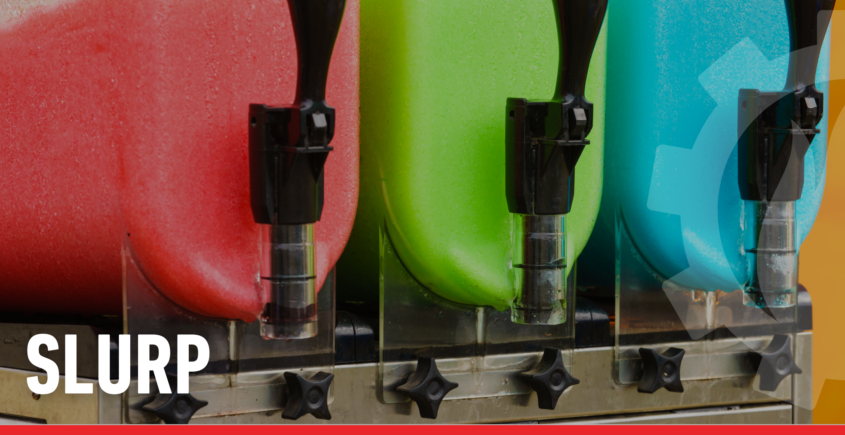Slurpee
All of us have those special childhood times and events we remember that bring great memories. So, here’s one for you… Where were you (and who were you with) when you had your first Slurpee (and associated brain freeze)? For me, it was at K-Mart back when they were called Icee’s, pretty sure, with some of my brothers and sisters (in full disclosure, there are days that by noon I don’t remember what I had for breakfast that morning, soooo keep that in mind!) I can still remember the refreshing taste, drinking it too quickly, and waiting for the impending brain cramp (see below to learn why). Today marks a wonderful special day, celebrated at over 8,000 locations across the country (and at spots around the world) … “7-11 Day,” when 7-Eleven stores hand out millions of free cups of the frozen Slurpee goodness. When you pull the lever on a Slurpee machine inside any 7-Eleven store on the planet, the fizzy, fluffy frozen beverage likely tastes just like the first one you ever tried. Introduced to the market in 1966, the Slurpee is arguably the world’s most popular (non-alcoholic) frozen drink. Here’s some fun information about Slurpees that I’m sure will take a whole bunch of you folks back to your childhood (or most recent visit to the convenience store). Enjoy! And many thanks to Amy McCarthy, a reporter at Eater.com, for her insights on Slurpee!

In the late 1950’s Omar Knedlik invented machines to make frozen beverages. The idea for a slushed ice drink came when Knedlik’s soda fountain broke down, forcing him to put his sodas in a freezer to stay cool, which caused them to become slushy. The result was popular with customers, which gave him the idea to make a machine to help make a “slushy” from carbonated beverages. Early prototypes for the machine made use of an automobile air conditioning unit.
When it became popular, Knedlik hired an artist named Ruth E. Taylor to create a name and a logo for his invention. She created the Icee name and designed the original logo, which is still used today.
After a successful trial of Icee machines in 100 stores, in 1965 7-Eleven made a licensing deal with The Icee Company to sell the product under certain conditions – that 7-Eleven must use a different name for the product, and that the company was allowed to sell the product only in 7-Eleven locations in the US, (a non-compete clause ensuring the two drinks never went head to head for distribution rights). 7-Eleven sold the product, known as the “Slurpee.”
Coined by advertising executive Bob Stanford, the “Slurpee” name is derived from the “slurp” sound that the drink makes when it is sucked through a straw. The Slurpee made its official debut in 1966, in two flavors, Coca-Cola and cherry, and was an instant success. (Unfortunately for Knedlik, he didn’t exactly possess the same kind of marketing genius – originally, he wanted to call his version of the beverage “Scoldasice,” but he eventually went with the word “ICEE.”
The Slurpee machine has a separate spout, or spigot, for each flavor at the front of a tumbler or freezer. When Slurpees were first introduced, the dispensing machine was located behind the counter, and the clerk dispensed the product.. In the Slurpee’s early history, flavors rotated much more frequently than today. Slurpee flavors were given novelty names such as Pink Fink, Adults Only, Moonshine, Kissin’ Cousin, Gully Washer, Sticky Icky, and Redeye.
In its 50-year history, the actual slushy machine has not changed dramatically. It, like most machines, has gotten smaller over time, but the mechanics (which for Slurpees are, of course, a 7-Eleven corporate secret) have largely stayed the same. That simplicity of process has everything to do with ensuring that Slurpees made in Detroit, Michigan, taste like Slurpees made in Dallas, Texas.
The modern-day Slurpee machine is fitted with a barrel surrounded by refrigerant used to keep the mixture cold. The Slurpee mixture flows into the barrel, begins to freeze, and is scraped away from the sides of the machine to form those fluffy ice crystals. Part of that chemistry is thanks to the drink’s most crucial ingredient, sugar, which acts as a sort of “antifreeze” that prevents the drink from freezing too hard, like a cube of ice. Sugar is a depressant to the freezing process.
The Slurpee machine itself is kind of like a soda machine and an ice cream freezer all in one. It adds carbonation while freezing the mixture.
A Brain freeze, or “cold-stimulus headache,” is a sudden, sharp pain in your head that you experience when eating or drinking something very cold too quickly. When a cold substance like a Slurpee quickly chills the roof of your mouth and back of your throat, your body recognizes this sudden drop in temperature. To try and warm the area back up, your body responds by rapidly increasing blood flow to your head. This causes blood vessels in your head to suddenly expand. Experts believe this rapid expansion of blood vessels likely activates the trigeminal nerve, a major nerve in your head and face responsible for transmitting sensory information. The nerve transmits these pain signals to your brain, but your brain interprets the pain as coming from your forehead, rather than the roof of your mouth. (This phenomenon is called referred pain).
While painful, brain freeze is not harmful and typically resolves quickly on its own. You can try warming up the roof of your mouth by pushing your tongue against it or by drinking something warm to help ease the symptoms.
Outside of the store, Slurpee has closely linked itself with events unfolding in popular culture. In the ’70s, a promotional single called “Dance the Slurp,” released on 45 rpm records, proved so popular it was played on mainstream radio. On eBay, thousands of listings hawk special-edition plastic Slurpee cups from the 1970s and beyond, emblazoned with images of Scooby-Doo, The Hulk, and Spider-Man for upwards of $20 each. The Simpsons weaved the drink into the fabric of its world – its parody, the Squishee, became so linked to the real-life Slurpee that 7-Eleven partnered with The Simpsons Movie in 2007 to sell the show’s fictional beverage from collectible cups.
At present, there are dozens of flavors that rotate through Slurpee machines. 7-Eleven also produces a number of regionally available flavors that have, to varying degrees, developed cult followings. In Detroit, Michigan, one of the world’s largest consumers of Slurpees, you’ll find Vernors Ginger Ale. Ohio’s Slurpee machines feature Faygo Cotton Candy soda. In Texas, Big Red and Dr Pepper are wildly popular.
Despite its relatively quiet first 50 years, expect change for the Slurpee to come at warp speed in the coming decades. “In the next five years, we expect Slurpee and our stores to change as much as they did in the last 50,” says Smith. When we were kids, the biggest rite of passage was asking your mom to go to 7-Eleven to get a Slurpee. You ride your bike, you hang out in the parking lot with your friends, and laugh about brain freeze. Now, kids interact totally differently. They’re getting a Slurpee, posting it on Snapchat, and recording the cold brain dance. Some things change, and some remain the same.
How did you do on last week’s logo contest?
Check out our logo guide for the “Freedom, Fireworks, Family & Friends” post here!






Leave a Reply
Want to join the discussion?Feel free to contribute!